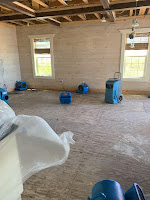The Crucial Role of Swift Drying in Preventing Microbial Growth After Water Damage Water damage caused by frozen pipe bursts can be a homeowner's nightmare, but the aftermath poses another significant threat: microbial growth. Swift and thorough drying is paramount to prevent the proliferation of mold and other harmful microorganisms in the affected areas. When a pipe bursts due to freezing temperatures, it releases a substantial amount of water into your property. This water, if not promptly and adequately dried, becomes a breeding ground for mold, bacteria, and other microbes. The key to mitigating these risks lies in understanding the importance of rapid water removal and efficient drying processes. Microbial growth thrives in damp and humid environments. Within as little as 24 to 48 hours, mold spores can begin to colonize and spread, posing health risks and causing structural damage. This is why immediate action is crucial in the aftermath of a frozen pipe burst. Water damage ...
Inspecting your freshly replaced roof is a vital step in ensuring a job well done! 🏠 Here’s a comprehensive guide to help you navigate the post-roof replacement inspection process: 1. Visual Assessment: Take a close look at your roof’s surface. 🧐 Check for any visible signs of damage, such as dents, scratches, or misaligned shingles. Proper alignment is key to a durable and aesthetically pleasing roof. 2. Shingle Inspection: Examine each shingle individually. Ensure they are securely fastened and show no signs of curling or lifting. A well-installed roof should have uniformly placed and firmly attached shingles. 🏡 3. Flashing Around Chimneys and Vents: Check the flashing around chimneys and vents. It’s essential for these areas to have a watertight seal. Any gaps or loose flashing could lead to leaks. 🚫💧 4. Gutter and Downspout Examination: Assess the condition of your gutters and downspouts. Make sure they are clear of debris and properly attached to your roof. Ad...



